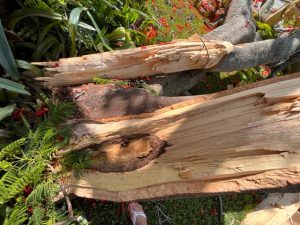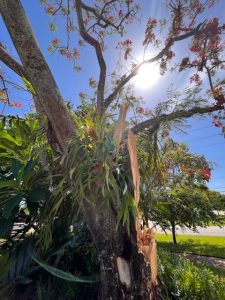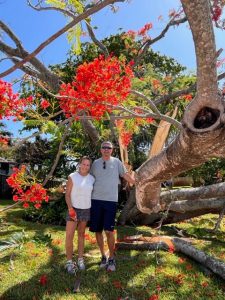A picture is often worth a thousand words.
As an ISA certified certified arborist, when I saw this huge Royal Poinciana collapsed on a sunny day, with no wind, rain, or other adverse weather conditions, I just had to stop and find out what happened!

What I discovered is a cautionary tale to all tree lovers.
Just because a tree looks good on the outside, doesn’t mean that it doesn’t have problems on the inside.
This seemingly healthy tree collapsed due to an undetected large area of decay in the center of the tree.

Never plant an Staghorn Fern or other epiphyte (orchids) in the crotch of a tree, as it tends to retain a lot of moisture which breaks down the bark allowing fungal spores in. Fungus is the nemesis of trees. If you ever needed convincing of that, just take a look at these photos.
Most people don’t realize that trees never “heal” when cut.
As humans, we have the capacity to completely heal over a wound, but the best that a tree can do is “compartmentalize” the wound, using special tissue and chemicals present in the branch collar. Without getting too technical, just know that anytime you cut off a limb of a tree, it will never heal completely, and in fact, that wound can and often does provide an entrance point for fungal decay. It’s this fungal decay that can make a tree unsafe. The darkened and decayed area was the point of attachment on the tree.



Large Wounds make trees more susceptible to failure.
When tree trimmers make large diameter cuts like this one above, especially on trees that don’t compartmentalize (“heal”) well. It will set that tree up for invasion by fungi. Think of it like an infection in a wound. Also realize that the older and more mature a tree is, the harder it is for it to compartmentalize.
Many trees do not heal or compartmentalize well, and it’s good to know which trees these are so that we can be more careful when pruning them, realizing that the larger the cut, the easier it is for a fungal infection to set in. Click on the link above to see which trees “heal” best.
Our trees are what give us a sense of place, provide habitat, and help mitigate climate change. We can’t afford to make mistakes in their care. To learn more about pruning and caring for trees, visit Professor Ed Gilman’s website.
Trees make good neighbors no matter what.
Sadly, the tree had to be removed, but because of this unforeseen tree failure event, we became good friends with our neighbors.



